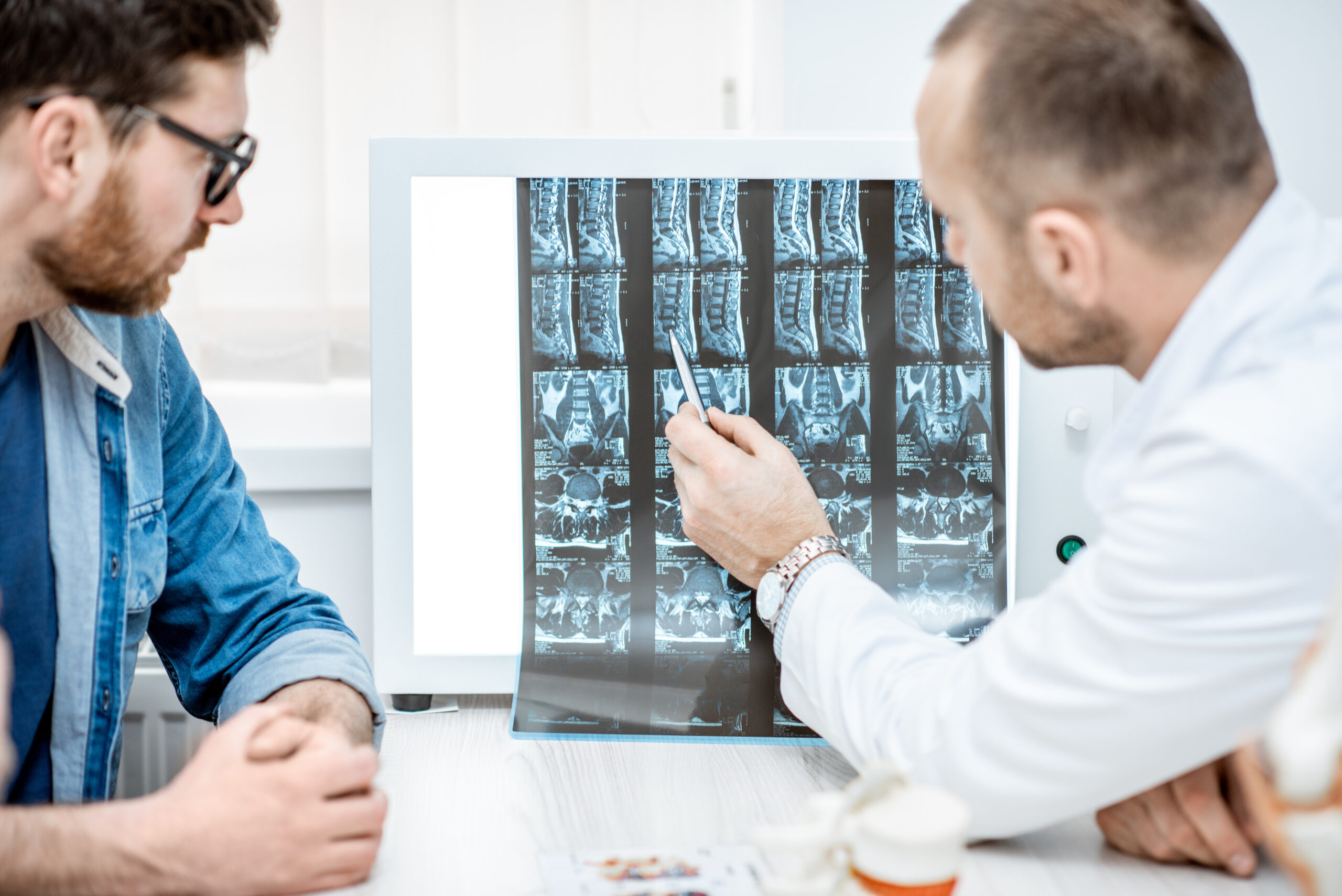
Herniated discs are a common source of back pain. Each year, more than three million Americans are diagnosed with herniations, and an estimated three percent of the population will have a herniated disc at some point in their lives. A herniated disc can occur in the cervical (neck) and lumbar (lower back) regions of the spine.
While nerve compression related to disc herniations is uncomfortable, it is usually treatable, especially if caught early on. Learning to recognize the symptoms of herniated discs and seeking treatment can prevent long-term damage.
Understanding Cervical and Lumbar Disc Herniation
A herniated disc occurs when the jelly-like nucleus in a spinal disc pushes against its outer shell, protruding out of the shell or forcing the disc out of place. When this happens, the disc often gets pushed into the nerve canal, leading to nerve compression and pain.
Patients with cervical disc herniation might experience pain in and around their necks, along with numbness and tingling in their arms. This is because the affected nerves are sending pain messages down these extremities.
Patients with lumbar disc herniation will experience pain in the lower back while also feeling numbness and muscle weakness in the legs. In severe cases, they may lose bladder and bowel control because the nerves controlling this system are affected.
Causes and Symptoms of Disc Herniation
A variety of factors contribute to the development of herniated discs. Many people develop these herniations through aging and natural wear and tear. Even if they maintain good spinal health and overall healthy habits, they might be more genetically prone to herniation.
Cervical herniated discs are often caused by aging, but they can also be the result of injury or poor posture. Lumbar herniated discs can be caused by improper heavy lifting, trauma to the area, or a sedentary lifestyle. For example, a herniation could develop over time because of a poor office seat or be caused by a sports injury or car accident.
Symptoms of a herniated disc often start small and then grow more severe. Patients might feel neck or lower back pain depending on the location of the herniation. Tingling, numbness, and weakness in the affected extremities are also common.
Treatment Options for Cervical & Lumbar Disc Herniation
There are both surgical and non-surgical treatment options available for patients living with disc herniations. Most doctors will develop a treatment plan of non-surgical options before moving forward with surgical intervention.
Non-surgical treatments may include physical therapy, pain management (through medication or epidural injections), hot and cold therapy, and lifestyle changes like taking supplements and embracing low-impact exercises.
Surgical treatments include artificial disc replacement or, potentially, spinal fusion. The type of surgical intervention you need depends on the location and severity of your herniation.
Symptoms of Cervical & Lumbar Disc Herniation
At first, your herniated disc symptoms might feel like muscle soreness or back pain from sitting for too long. However, if left untreated, they can become more severe, and additional symptoms may develop. Here is what you can expect if you have a vertical or lumbar disc herniation.
Symptoms of Cervical Disc Herniation
The most common symptom of a cervical herniated disc is neck pain, which might feel like sharp stabs or a chronic ache. Over time, you may notice pain radiating down the arms or shoulders.
When the herniated disc pushes into the nerves, it can create feelings of numbness, tingling, and weakness in the upper body. These feelings can travel down to your hands and fingers.
Symptoms of Lumbar Disc Herniation
Lumbar herniated discs can also cause back pain, which can increase to the point where it radiates down your legs. This is a condition known as sciatica. This pain can also lead to feelings of numbness and weakness in the legs, making it difficult to walk or move around comfortably.
Diagnosis and Assessment of Disc Herniation
If you have neck or lower back pain that is worsening or failing to go away, schedule an appointment with your doctor. They will determine if you have a herniated disc and develop a treatment plan that puts you on a path to healing.
Diagnosis starts with a medical examination. Tell your doctor about your symptoms, when they occur, and their severity. Your doctor may ask you to complete a few motion tests and strength evaluations to see how you can move.
If your doctor suspects you have a herniated disc, they may recommend imaging tests, such as an MRI or CT scan, to examine your back. These tests will confirm the location and severity of the herniated disc.
Non-Surgical Treatment Options
Usually, your doctor will immediately develop a non-surgical treatment plan to help your herniation. Up to 90% of patients will recover from their herniated discs without surgery. Even if you eventually need surgery, these non-surgical treatments can reduce discomfort.
Physical Therapy
Targeted physical therapy exercises can strengthen the muscles around the affected area, reduce pain, and improve mobility. Your doctor will either walk you through a few exercises to try or refer you to a therapist to meet with on your schedule. Each patient should receive customized therapy programs based on the location of the herniation and their physical ability. This way, you focus on the correct area and do exercises within your capabilities.
Pain Management Techniques
Along with therapy, your doctor may recommend over-the-counter and prescription medications, such as NSAIDs and muscle relaxants. They may also try epidural steroid injections, which reduce inflammation and relieve pain in both cervical and lumbar herniations.
These medications, along with hot and cold therapy, aim to reduce inflammation while relaxing your muscles. This can make moving around easier, allowing you to focus on physical therapy exercises. All aspects of non-surgical treatment work together.
When Is Surgery Necessary for Disc Herniation?
If your herniated disc does not respond to non-surgical intervention, your doctor may recommend moving forward with a surgical operation. They also might recommend this path if your herniation is severe enough due to injury or trauma.
Surgical Options for Cervical Disc Herniation
Your doctor may recommend an anterior cervical discectomy and fusion (ACDF), a standard surgical option where the damaged disc is removed and the vertebrae are fused. They also might schedule a disc replacement surgery. Dr. Lanman will usually recommend arthroplasty if the patient is a candidate for disc replacement surgery. This less invasive option preserves neck mobility while relieving pressure on the nerves. The damaged disc is removed and replaced with a durable, flexible artificial model.
Surgical Options for Lumbar Disc Herniation
Patients with lumbar disc herniation can undergo similar surgical treatments for patients who have a lumbar disc herniation. They might need a microdiscectomy, which is a minimally invasive procedure that removes the part of the herniated disc pressing on the nerve. Another is lumbar disc replacement, which is similar to cervical disc replacement. This option can restore movement and alleviate lower back pain.
Patients with severe trauma in the spine or multiple herniations may need multi-level disc replacement (when two or three damaged discs are removed at the same time and replaced with artificial ones).
The Role of Disc Replacement in Treating Herniated Discs
Even though disc replacement surgery has a high success rate, many people are nervous when heading to their scheduled appointments. However, this procedure can have a tremendous positive impact on patients and provide long-term support.
Advantages of Disc Replacement Surgery
Disc replacement, whether in the cervical or lumbar region, allows for greater mobility than traditional fusion surgery. After they heal, patients can bend, twist, and move comfortably again. Many can resume their favorite hobbies and exercises after fully recovering from the operation.
Patients who undergo disc replacement often experience faster recovery times and better long-term pain relief. This is why disc replacement is often preferred by doctors over spinal fusion.
Who Is a Candidate for Disc Replacement?
Every patient is unique, so your doctor will recommend disc replacement on a case-by-case basis. However, fusion is often recommended for people who have severe disc degeneration and don’t respond to non-surgical treatments. They also need to be in good physical health to handle the operation.
Recovery and Long-Term Outlook
Everyone’s recovery timeline will vary depending on where the herniation was and how that patient heals. However, most people can return to office work within two to three weeks of the operation. They can resume light sports within six weeks and return to physical work within three months. Most patients are completely healed between three and six months.
Patients can also take steps to maintain their spinal health post-surgery. They can take up low-impact exercises, make lifestyle changes to improve their posture and overall health, and schedule regular check-ups with their doctor. Your doctor will want to see you at least annually following your operation to ensure your herniation doesn’t return and new ones don’t form.
Final Thoughts from Dr. Todd Lanman on Disc Herniation Treatment
Both cervical and lumbar disc herniations are uncomfortable, but most patients will recover without needing surgical intervention. Through a dedicated treatment plan that includes physical therapy, medication, and lifestyle changes, they can reduce and eliminate uncomfortable symptoms like pain, numbness, tingling, and muscle weakness. If these symptoms do not subside, surgical intervention may be necessary.
If you experience back pain or have a persistent herniated disc, request a consultation with Dr. Todd H. Lanman, a board-certified, award-winning spinal neurosurgeon with more than 30 years of experience. He is a leader in artificial disc replacement surgeries and is known for his approach to personalized patient care. Schedule an in-depth evaluation with Dr. Lanman to treat your disc herniation, or use the Top Doctors Directory to find a trusted professional near you.
FAQs
What are the symptoms of advanced sciatica?
Patients with severe sciatica may experience weakness, numbness, and shooting pain in their legs. Walking may become difficult because of these pain levels. This pain could get worse when patients move suddenly, cough, or sneeze.
Can sciatica lead to permanent nerve damage?
Sciatica can cause permanent nerve damage. This is because there is severe damage to the sciatic nerve in the spine. Patients may even experience loss of bowel and bladder control because of this nerve damage.
When is surgery necessary for sciatica?
Doctors often start with non-surgical intervention to treat sciatica and its root cause. However, if symptoms persist, your doctor may recommend surgery. They want to intervene before you develop permanent nerve damage.
How long does it take to recover from disc replacement surgery?
Every patient is different, but most people heal within six weeks and completely recover within six months. Your doctor will let you know when you are approved to return to office work, resume physical work, and return to your favorite hobbies and activities.
What are the risks of leaving sciatica untreated?
Patients who ignore their sciatica may develop permanent nerve damage, which causes lasting discomfort. They may also experience severe pain that makes it difficult to move and muscle weakness that makes basic tasks difficult.
Ready to reclaim your life? Get in touch with Dr. Lanman Today.
FOLLOW US ON SOCIAL MEDIA | @ADRSPINE





